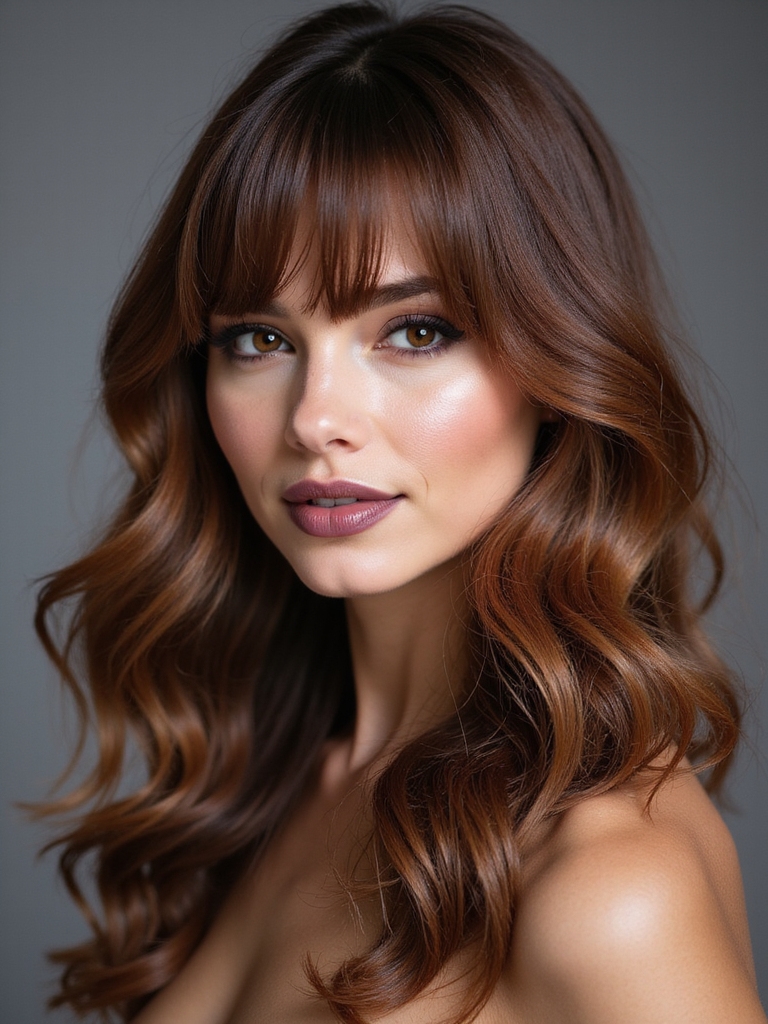I love how dynamic layered curtain bangs can instantly add movement and personality without shouting for attention. They skim the face, blend into longer layers, and give you that effortless, lived-in vibe—great if you want soft framing or a bit more edge.
I’ll walk you through who they suit, how to ask your stylist, and simple styling tricks that actually work—but first, let’s figure out if they’ll flatter your face shape.
What Are Dynamic Layered Curtain Bangs?

Think of dynamic layered curtain bangs as the cooler, more flexible cousin of classic curtain bangs — I love how they frame your face with soft, face-skimming layers that move, breathe, and can be styled in multiple ways.
I describe them as versatile, textured front pieces cut into graduated layers for movement, easy styling, and subtle volume—playful, low-maintenance, and great for adding instant personality.
They pair beautifully with soft layers, creating seamless movement and added dimension.
Which Face Shapes Benefit Most From Curtain Bangs

I love how curtain bangs can instantly balance a long face by adding width at the forehead.
They also do a sneaky softening job on angular jawlines, breaking up harsh angles with gentle layers.
Stick with me and I’ll show which tweaks make them work best for your shape.
Curtain bangs are especially flattering on round faces because they create the illusion of length and framing with long curtain bangs.
Balances Long Faces
Because I’ve seen curtain bangs work wonders on long faces, I can’t help but recommend them when you want to soften length without losing your look.
They create horizontal movement across the forehead, visually shortening the face and adding width. I love how they frame the eyes and cheekbones subtly, making proportions feel balanced while keeping your style modern and effortless.
Curtain bangs are a versatile option that create movement and framing for many hair types.
Softens Angular Jawlines
If you’ve got a sharp jawline that you love but want to soften a touch, curtain bangs are your low-effort secret weapon — they break up hard angles by drawing attention to the center of your face and skimming the cheekbones.
I’ll tell you: the gentle curtain shape adds softness without hiding structure, framing those strong lines with movement and flattering balance.
Layered cuts enhance this effect by adding texture and dimension, making curtain bangs blend seamlessly with the rest of your hair layered haircut.
Choosing the Right Length and Layering for Your Hair Type

I’ll help you pick the perfect curtain bang length to flatter your face shape—whether you want something wispy that softens a square jaw or a longer sweep to lengthen a round face.
We’ll also chat about how to layer based on your hair’s texture so curls, waves, and fine strands behave instead of fight.
Tell me your hair type and face shape and I’ll suggest exact lengths and layering to try.
Layered Hair With Curtain Bangs add depth and movement for a softer silhouette, especially when combined with soft layered hair.
Face-Shaping Length Choices
When I’m helping you pick curtain-bang lengths, I focus on how your face shape and hair texture will play together so the cut flatters, not fights, your features. I guide choices that balance proportions, soften angles, and highlight your best bits—no one-size-fits-all here.
- Short for round faces to add height
- Chin-length to slim wider jaws
- Long to elongate
- Side-swept for square faces
- Wispy for heart shapes
Layering for Hair Texture
Matching layers to your hair texture makes curtain bangs actually work for you, not against you.
I size layers differently: fine hair gets softer, longer layers to fake volume; thick hair benefits from shorter, face-framing slices to reduce bulk; wavy hair takes staggered lengths to enhance movement.
I also tweak bang length so styling’s easy—effortless, not high maintenance.
How to Ask Your Stylist for Layered Curtain Bangs

Think of this like ordering your favorite coffee — I’ve got a few clear cues you can give your stylist so you actually walk out with the layered curtain bangs you want.
I’m concise, show photos, and ask for face-framing layers, soft graduation, and parting options.
Be open to tweak.
- Bring photos
- Specify length
- Mention texture
- Ask about styling
- Confirm maintenance
Step-by-Step Cutting Techniques Stylists Use

I’m going to walk you through the exact cutting moves stylists use so you’ll know what’s happening at the chair.
We’ll cover clean sectioning and tension control, playful point cutting for lived‑in texture, and how we place those face‑framing layers to flatter your features.
Stick with me and you’ll spot the little details that make curtain bangs sing.
Sectioning and Tension Control
While you’ll see me snap a few precise partings, what really sets a clean curtain-bang cut apart is how I section and control tension from start to finish.
I explain each panel, adjust grip, and test fall constantly — it’s precise but fun. My secret? Consistency and small tweaks.
- Even sections
- Uniform tension
- Natural fall checks
- Gentle combing
- Repeated visual checks
Point Cutting for Texture
Starting with small, deliberate snips, I use point cutting to feather the ends and build that lived-in texture curtain bangs need.
I angle scissors vertically, tap into sections, and remove tiny bits for softness.
I watch hair fall, adjust rhythm, and keep movement airy—not chunky.
It’s playful precision: little cuts, lots of bounce, and a natural, easy finish that reads effortless.
Face‑Framing Layer Placement
When framing the face, I map the line first so every layer falls where you want it to—no guesswork, just placement. I section, angle, and check proportions, then snip with intention to sculpt movement that flatters.
Here’s the simple logic I follow:
- Find natural part and cheekbones
- Angle sections toward jawline
- Cut slightly longer at temples
- Blend with point cuts
- Cross-check symmetry
Styling Tools and Products That Enhance Movement

I love reaching for a few trusty tools and products that give layered curtain bangs that effortless, swishy movement — and you can too.
I grab a small round brush, lightweight texturizing spray, and a blow dryer with a nozzle.
A light cream or mousse tames frizz without weighing layers down.
Finish with flexible hairspray for airy hold and natural bounce.
Quick Daily Styling Routine for Busy Mornings

Usually I grab my round brush and blow dryer and get my curtain bangs looking presentable in under five minutes.
I talk you through my tiny routine, quick and fun, so you can dash out with flair.
- Prep with lightweight mist
- Brush through for natural fall
- Direct warm air outward
- Finger tousle for movement
- Finish with light hold spray
Creating Volume and Texture Without Heat Damage

I swear by air-dry tricks to get lift in my curtain bangs without turning up the heat — think scrunching, gentle twisting, and using a wide-tooth comb as my friend.
I’ll walk you through the product layering I use (light mousse, a texturizing spray, then a touch of cream) so each piece holds shape and still feels soft.
Believe me, you can build serious volume and texture while keeping your hair healthy.
Air-Dry Styling Techniques
Often I reach for air-dry tricks when I want bouncy, textured curtain bangs without frying my hair — and you can too.
I scrunch, twist, and clip to coax movement while keeping strands healthy. Quick routines save time and build shape naturally.
- Scrunch with a lightweight cream
- Twist damp sections away from the face
- Use a soft clip to set bend
- Diffuse on cool air briefly
- Finger-comb for lived-in texture
Product Layering Tips
When layering products, I like to think of it as dressing your bangs in pieces that each do a little job — one for lift, one for texture, one for hold.
I start with a lightweight root lifter, follow with a salt spray midlengths for grit, then finish with a flexible hairspray at the ends.
Tap sparingly to avoid crunch—blend with fingers for soft movement.
Transitioning From Full Fringe to Curtain Bangs

If you’re ready to swap a full fringe for softer curtain bangs, I’ll walk you through the easiest way to make that change without freaking out or chopping too much at once.
I’ll guide gradual thinning, side parting, and using clips to test the look before committing—gentle, reversible steps.
- Start with long layers
- Thin center bulk
- Create a soft middle part
- Use clips daily
- Visit a stylist for shaping
Maintaining Shape: Trimming Frequency and Tips

Regularly I trim a little more often than I used to, because curtain bangs need a bit of babysitting to keep that soft, face-framing shape.
I check length every 4–6 weeks, snipping tiny vertical cuts with sharp shears, dusting split ends, and trimming longer layers to preserve movement.
Quick at-home touchups work, but professional tidy-ups keep the silhouette crisp and effortless.
Adapting Curtain Bangs for Curly and Coily Hair

Because curly and coily textures love their own rules, I tweak the classic curtain-bang shape so it complements your natural pattern instead of fighting it.
I cut with shrinkage, encourage a rounded frame, and teach simple styling that respects curl clumps.
- Adopt length for pattern
- Cut dry when possible
- Soften edges, avoid blunt lines
- Use leave-in for definition
- Refresh with water mist
How Color and Highlights Complement the Layers

I love how a few well-placed highlights can make those layers sing, lifting texture and movement without overpowering your natural curl pattern.
I’ll suggest face-framing lighter pieces to accentuate the curtain shape, subtle babylights for depth, and warm tones to soften edges. Think contrast that reads natural — it brightens movement, adds dimension, and keeps your layered bangs feeling fresh and effortless.
Styling for Special Occasions: Sleek vs. Tousled Looks

When I’m getting ready for an event, I love deciding if to go sleek and polished or tousled and undone—each vibe lets curtain bangs play a different role. I pick sleek for chic frames or tousled for flirty movement.
Here’s how I think about it:
- Smooth finish for formal confidence
- Soft waves for romantic energy
- Shine spray for glam
- Texture spray for edge
- Quick touchups for lasting impact
Common Mistakes to Avoid When Styling Curtain Bangs

You can pick sleek or tousled all you want, but a few common slip-ups will ruin either look fast — and I’ve learned them the hard way.
Don’t overuse product, avoid heavy blunt cuts, and resist constant heat without protection.
Trim too often? Nope.
Ignoring your natural part? Big mistake.
Small tweaks keep curtain bangs lively, effortless, and flattering.
Growing Out Curtain Bangs Gracefully

Growing out curtain bangs can feel like coaching unruly toddlers—messy, stubborn, but totally manageable with the right tricks.
I’ve learned to welcome awkward stages, use clips, and sneak trims to shape the face while length grows. Patience plus tiny hacks win.
- Clip back strategically
- Use dry texturizing sprays
- Schedule mini trims
- Play with headbands
- Welcome curtain-style parting
So, that’s the lowdown on dynamic layered curtain bangs — they’re playful, flattering, and way easier than you’d think. Try a shorter or longer sweep depending on your face shape, ask your stylist for graduated layers and soft texturizing, and don’t be afraid to mess around with color to boost movement.
For everyday styling, keep it simple: a little air-dry, a light texturizer, or a quick blow-dry. Wear them messy or sleek — they’ll make you feel put-together.







